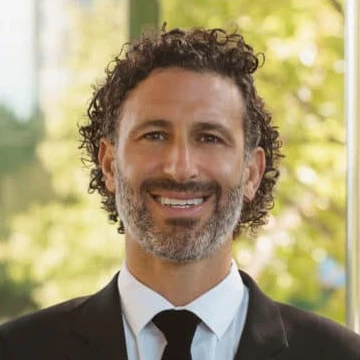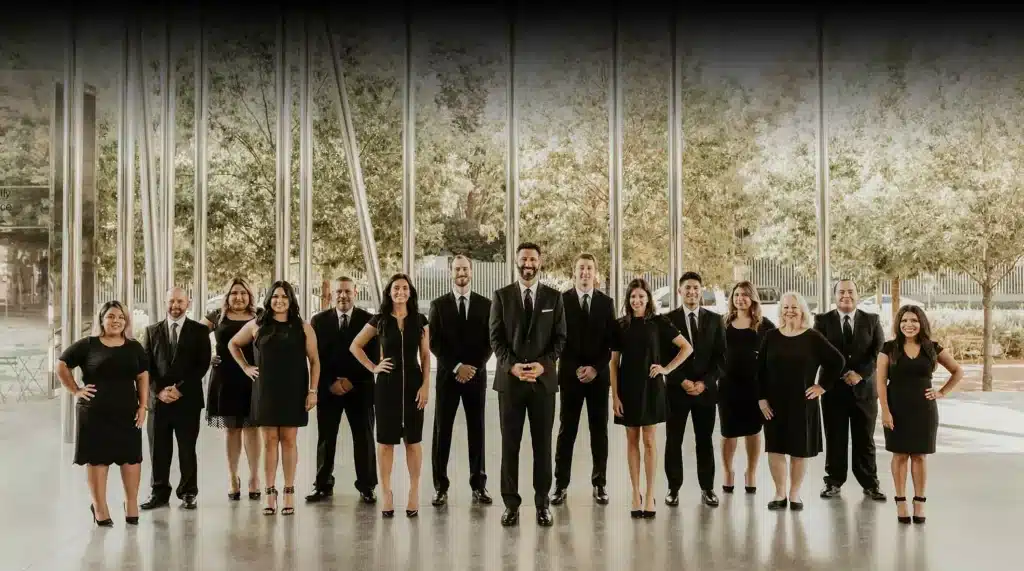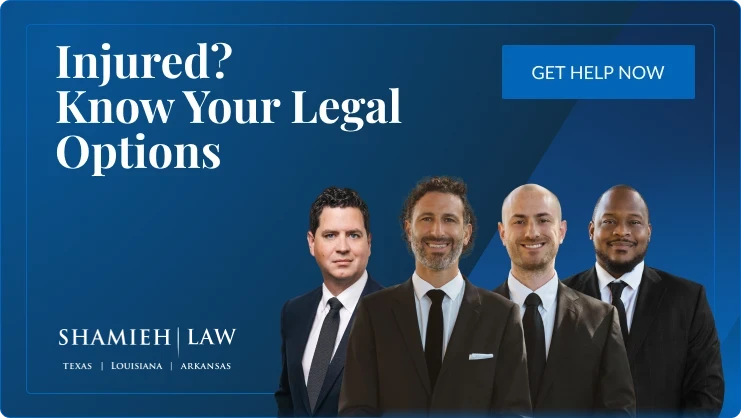Louisiana Motorcycle Accident Attorney
40+ Years
of Combined Experience
5.0 Google Rating
with over 400 Reviews
Over $200M
Won for Clients That Have Become Family

Content Reviewed By:
Date Last Updated: June 23, 2025
Table of Contents
- Justice & Compensation for Motorcycle Accident Victims
- Deadline to File a Motorcycle Accident Lawsuit
- Fees – We Use the Contingency Fee Model
- Legal Advice from Licensed Motorcycle Accident Lawyers
- Do I Need a Motorcycle Crash Attorney? – Steps We Take For You
- Start a Free Consultation
- Common Motorcycle Accident Injuries
- Common Causes of Motorcycle Accidents
- Types of Motorcycle Crashes
- Steps To Take After a Motorcycle Accident
- FAQs About Motorcycle Accident Lawsuits
When you’ve been injured in a motorcycle crash or lost a loved one, the experienced, compassionate Louisiana motorcycle accident lawyers at Shamieh Law are here for you. We will fight for the justice and compensation you deserve. We’ve collected over $200 million for our clients and their families. Get started with a free and confidential case review.
Trusted Motorcycle Accident Law Firm will Fight for Your Justice and Compensation
The motorcycle accident attorneys at Shamieh Law aim to recover compensation, also called damages, so that you, as a victim or family member, can be “whole” again in the eyes of the law.
Compensation typically covers financial losses related to the motorcycle crash, including the following:
- Medical Expenses – both now and in the future, including hospitalizations, surgeries, ongoing treatments, and therapies
- Lost Wages – when you miss work due to your injuries
- Lost Future Income – when you cannot continue with your chosen profession
- Pain and Suffering
- Loss of Consortium – when a loved one has been killed, or their quality of life has been so diminished that your relationship with them has suffered
- Punitive Damages – meant to punish the wrongdoer for their actions
If someone you love has died from motorcycle accident injuries, our hearts go out to you. We can help you file a wrongful death lawsuit to help your family heal and move forward with the financial support needed.

Deadlines: The Statute of Limitations for Motorcycle Accident Lawsuits in LA
In Louisiana, the statute of limitations for filing a lawsuit resulting from a motorcycle accident is typically one year from the date of the accident. If the person involved in the accident is a minor or mentally incapacitated, the statute of limitations may be extended until they reach legal age or can provide full consent.
It’s crucial to understand that a statute of limitations defines how long you have to file a motorcycle accident injury claim in each state. Missing this deadline may mean you cannot proceed with your case and pursue compensation. Act now before the motorcycle accident deadline expires.
Work with Our Louisiana Motorcycle Crash Attorneys in These Cities and More
- Baton Rouge
- Bossier City
- Kenner
- Lafayette
- Lake Charles
- Metairie
- Monroe
- New Orleans
- Shreveport
Our Motorcycle Accident Injury Lawyers Use Contingency Fees
When you work with the motorcycle accident lawyers at Shamieh Law, our law firm funds all costs of investigating the accident scene, gathering evidence, hiring expert witnesses, and building a solid case.
We use the contingency fee model. That means you pay nothing unless we win your case. When you win, our motorcycle law firm collects a percentage of your financial recovery to cover the expenses of your case. If you do not win, you owe us nothing. We are prepared to put the full force of our Texas and Louisiana motorcycle accident law firm to work on your case. Get started with a free consultation today.
Motorcycle Crash Lawyers Here to Provide Legal Advice
Do not go it alone after a motorcycle accident with injuries. The Louisiana and Texas motorcycle accident injury attorneys at Shamieh Law will guide you through the complex personal injury claims and lawsuit process. Our licensed attorneys will provide ongoing legal advice throughout your case.
Under the state negligence laws, cases involving motorcycle accidents and personal injuries fall under specific negligence laws
Louisiana is a Pure Comparative Negligence State
In Louisiana, you can file a lawsuit to collect compensation after a motorcycle crash with injuries. However, if the court finds that you hold partial responsibility for the accident, then that percentage of the award will be reduced.
For example, if you were 80% at fault for the crash, you could still recover 20% of your damages.
Do I Need a Motorcycle Accident Injury Attorney? Actions We Take for You
We strongly urge all injured victims to consult a licensed motorcycle accident lawyer for personal injury cases.
Some of the most important reasons why hiring a motorcycle accident lawyer is vital to winning a lawsuit include the following:
- We’ll deal with insurance companies — who often seek to minimize or deny claims — and fight for a fair settlement that considers all damages and losses suffered.
- We work on contingency, meaning you are not responsible for fronting the costs to gather evidence, investigate, and interview expert witnesses. We have substantial financial resources to fund the costs of a motorcycle accident lawsuit.
- We can help provide valuable resources to those dealing with emotional trauma following a motorcycle crash.
- Motorcycle accident lawsuits can take years to reach their conclusion. We’ll focus on your case so that you can focus on healing.
Steps of the Motorcycle Accident Injury Claims Process
Here is a broad overview of the injury claims process in Texas and Louisiana:
- Select a personal injury attorney. Choose an experienced motorcycle accident law firm committed to receiving the best results for your case.
- Collect evidence. Your motorcycle accident attorney will gather information and supporting evidence to give you the best chance of settling your case in or out of court. At this point, you can present any photographs and documentation regarding the incident or your injuries.
- Document your injuries. Your insurance company, the courts, and the other driver’s insurance company will expect proof of your injuries. Medical records showing that you went to the emergency room and received medical care can significantly strengthen your case. If needed, your motorcycle accident attorney will meet with experts to gather evidence to help prove your case.
- Negotiate a settlement or file a lawsuit. In the best-case scenario, you can negotiate a settlement that works for you and saves you the cost of a long-drawn court battle. However, if needed, our experienced motorcycle crash attorneys are ready to go to court to help you win the compensation you deserve.
- Obtain the outcome. If the case does result in a trial, a jury or judge will listen to the evidence presented by our motorcycle accident injury attorneys and those of the other driver. We will fight for a fair verdict.
Free Case Review with a Reliable Motorcycle Crash Law Firm in LA
During your free case evaluation, you’ll have a chance to share your account of the accident along with the photos and other info you may have collected. We may review critical medical records, police reports, and more. This is a confidential case review, and our motorcycle accident lawyers will provide all the information you need to decide how to proceed.
Common Motorcycle Accident Injuries
Some of the most severe motorcycle accidents result in death, leaving behind loved ones, and expensive medical bills. In some cases, the family of a motorcycle accident victim may be able to file a wrongful death lawsuit.
Over the last ten years, motorcycle accident deaths have doubled in the United States, accounting for 14 percent of all motor vehicle crash deaths [1].
This is due to numerous factors, from the prevalence of smartphones and other devices taking drivers’ attention from the road to inexperienced riders.
Some of the most common motorcycle accident injuries include:
- Head and neck injuries
- Injuries to the legs and feet
- Road rash and burns
- Concussion
- Depression
- Head trauma, such as traumatic brain injury (TBI)
- Spinal cord injuries
- Muscle damage
- Biker’s arm
Causes of Motorcycle Accidents
Motorcycle accidents usually occur when drivers of other vehicles are not paying attention or are unaware of a motorcycle’s speed or presence.
Researchers have found that the human brain has difficulty perceiving small objects that are closer (such as a motorcycle in the next lane) than large objects at a distance.
This helps explain why so many accidents involving motorcycles occur when a vehicle changes lanes.
Other reasons motorcycle accidents happen include:
- Driver error
- Faulty equipment
- Speed
- Distraction
- Dangerous conditions
To learn more about how we can help you following a motorcycle accident, please contact Shamieh Law and schedule a free consultation today.
We proudly serve as Louisiana Personal Injury Attorneys in Lake Charles and throughout LA.
Types of Motorcycle Accidents
The following motorcycle accident types often result in personal injuries and fatalities:
- Low-side accident – Low-side motorcycle accidents happen when a motorcyclist falls off their bike while turning.
- Lane Splitting Accident – Also known as “lane filtering,” involves a motorcycle riding between two lanes of stopped or slowly moving cars, where riders become vulnerable to collisions with other vehicles, especially at high speeds.
- Crossing an Intersection Accident – Crossing an intersection on a motorcycle can be incredibly dangerous, putting riders in a precarious situation at the mercy of other drivers. A momentary lapse in judgment or failure to recognize an approaching motorcyclist can have catastrophic consequences.
- Hitting a Fixed Object Accident – Hitting a fixed object is one of the most common motorcycle accidents, accounting for nearly 25% of fatal biker crashes in the United States. These accidents typically occur when a rider loses control and veers off the roadway, striking an immovable object such as a utility pole, tree, or guardrail.
- Head-On Collisions/Overtaking Accidents – These accidents occur when two vehicles crash into each other while traveling in opposite directions at high speeds, resulting in severe and often fatal injuries. In addition, those involved in head-on collisions are more likely to be thrown from their bikes, further exacerbating potential injuries.
- Right of Way Violations/Failure to Yield Accidents – When other drivers fail to recognize motorcyclists’ rights and do not yield the right of way, these accidents can result in severe injury or death for the cyclist.
- Motorcycle and Vehicle Turning Left or U-Turns – Motorcycles are particularly vulnerable to such collisions due to their smaller size and lack of protection. Motorcyclists can suffer serious injuries such as broken bones, head trauma, or even death in these accidents.
- Sudden Stops, Panics, or Swerves – These sudden movements occur when a motorcyclist has to make abrupt corrections to avoid an imminent crash, such as when another vehicle makes an unexpected lane change or cuts them off.
- Unsafe Passing on the Shoulder of Roadways – when drivers pass motorcyclists in an unsafe manner, often by driving on the shoulder of the road or merging into a lane that a motorcyclist already occupies, it can be hazardous for both parties
- Animal Strikes – Every year, thousands of riders collide with animals, resulting in serious injuries, fatalities, and extensive property damage. The most typical accident involving animals is when a rider hits a deer or bird mid-flight.
Steps to Take After a Motorcycle Crash
When a crash involves injuries, medical attention should always take top priority.
Here are some of the essential steps to take after a motorcycle crash when possible:
- Ensure that you are in a safe location after a collision.
- Seek medical assistance for injuries and go to the emergency room immediately after the accident for a thorough check.
- Call the police so that you have a case number and documentation of the accident.
- Take many photos with your phone of street signs, skid marks, vehicles, and other details about the scene.
- Collect information, including the identification of the driver and passengers of the other vehicle and any other witnesses. Write down the plate numbers and insurance and registration information to have it when you file your insurance claim.
- Contact our motorcycle accident law firm as soon as possible since motorcycle case deadlines exist. And consult with an attorney before calling your insurance company.
- Be sure to attend all medical appointments. Skipping appointments may imply less severe injuries during a lawsuit.
- Speak to the other parties as little as possible to avoid accepting responsibility. Do not comment on your physical condition, as that can be used against you later.
- Avoid posting anything on social media about the accident.
- Cooperate with your insurance company, but don’t volunteer too much information to the insurance adjuster. They work for the insurance company, and part of their job is reducing the amount paid on your claim.
- Only release information or sign something for the other driver’s insurance company after consulting your motorcycle accident attorney.
Frequently Asked Questions About Motorcycle Accident Lawsuits
Whether or not you should sue after a motorcycle accident depends on the circumstances that led to the accident. If there was another party at fault, such as another vehicle or a negligent driver, then it may be in your best interest to take legal action if you have suffered physical, emotional, and/or financial damages. The best action is to speak with our experienced motorcycle accident lawyers, who can review your case and help you decide which option is strongest.
A motorcycle accident lawsuit is a legal dispute when one party alleges that another party caused an accident due to negligence or a wrongful act. The injured party may often seek compensation and/or punitive damages for losses such as medical bills, lost wages, pain and suffering, emotional distress, and more.
You may be entitled to various types of damages depending on the circumstances of the accident and injuries. These may include economic losses such as medical expenses, lost wages, and property damage, and non-economic losses such as pain and suffering, mental anguish, emotional distress, loss of consortium (e.g., companionship), and more.

Contact an Experienced Motorcycle Accident Injury Lawyer To Protect Your Rights
If you were recently involved in a motorcycle accident, contact our team at Shamieh Law to schedule a free case consultation. We’re always available at 866-552-1801. Count on our legal team’s highest level of service and support. We’ll use our years of experience handling motorcycle accident cases like yours to help you fight for compensation and justice.





